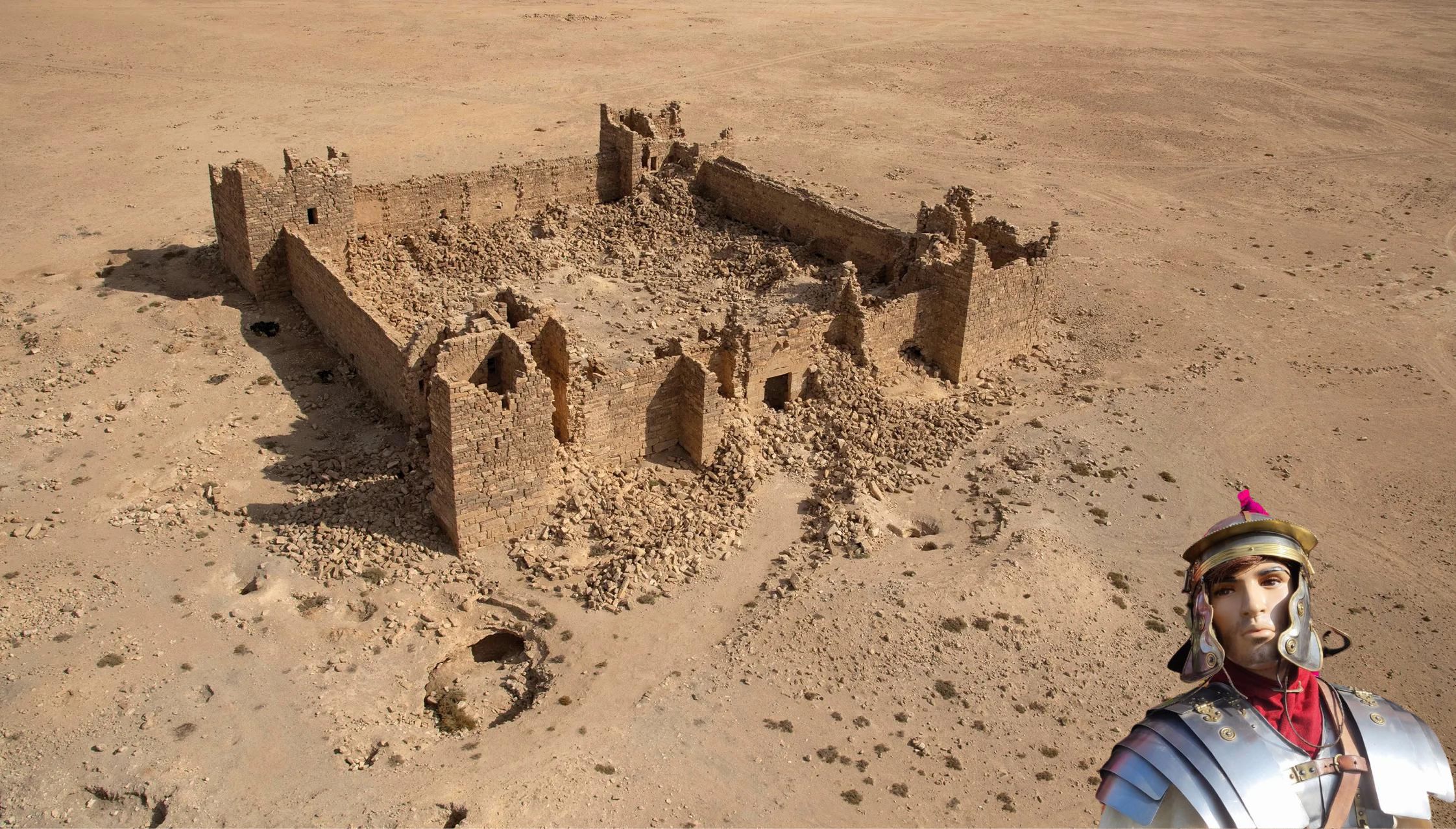The Qasr Bashir Roman Fort, Situated in the Jordanian desert, stands out as an impeccably preserved Roman fort.
Qasr Bshir, in latin Castra Praetorii Mobeni or Praetorium Mobeni, Arabic قصر بشير, also known as Qasr Beshir, Qasr Bashir and Bser, is a late Roman military fortress whose crew was responsible for security and surveillance tasks on the front Limes Arabiae et Palestinae in the late ancient province of Arabia.
The presence of inscriptions allows us to date the construction of the fort to 293-305, when the Romans constructed more forts in this sector of the frontier. Qasr Bshir was in use throughout the fourth century and may have been abandoned in the early fifth century. It was certainly reused in the Umayyad age, because there are traces of a machicolation above the entrance, an invention commonly to postdate the Arab conquests.
The Limes Arabicus was a desert frontier of the Roman Empire, running north from its start in the province of Arabia Petraea. It ran northeast from the Gulf of Aqaba for about 1,500 kilometers (930 mi) at its greatest extent, reaching northern Syria and forming part of the wider Roman limes system. It had several forts and watchtowers.
The reason of this defensive limes was to protect the Roman province of Arabia from attacks of the barbarian tribes of the Arabian desert. The main purpose of the Limes Arabicus is disputed; it may have been used both to defend from Arab raids and to protect the commercial lines from robbers.
The remains of the fortification, some of which have been preserved up to the second floor, form the best preserved fort in present-day Jordan even if numerous earthquakes caused severe damage. According to various sources it even seems to be the best preserved Roman fortification in the entire Middle East region.
The site is located about 80 kilometers south of the Jordanian capital Amman at 800 meters above sea level and 15 kilometers northwest of today’s small town Al-Qatrana .
JTB
20 min from el-Qatrana and 1.30 h from Amman
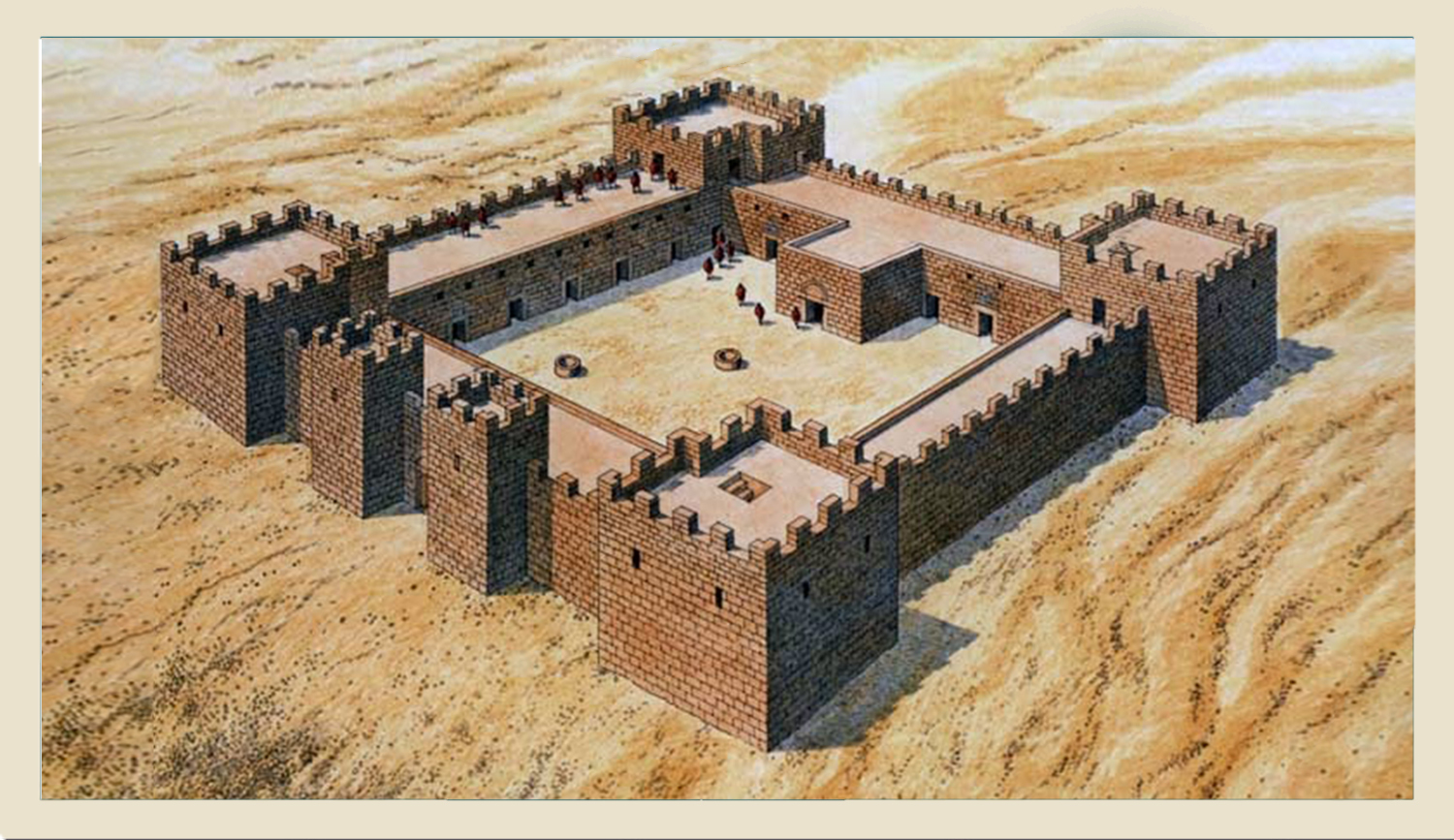
The Praetorium Mobeni is only about 15 kilometers, so something a day’s march northeast of the legionary camp Betthorus (el-Lejjun) in the wide, slightly hilly plain of the Jordanian steppe of about 8,000 square kilometers.
The table landscape around the fort is criss-crossed by numerous flat small wadis, all of which drain west into Wadi Mujib when it rarely rains.
In the north, around three kilometers away, there is a range of hills overlooking Wadi Su’eida, a tributary to Wadi Mujib. There is a low ridge about two kilometers to the east.
In this area the climate corresponds to the subtropisch, so it is arid and dry which is typical of desert landscapes.

The garrison is located in the middle of a flat depression on the west side of a slight topographical elevation and is oriented to the south-west. A small deposit of loess covers this elevation. From the towers of the fortification, the soldiers had an excellent view of the treeless land.

The view was only restricted to the south. The rear watchtowers Qasr Abu el-Kharaq, Qasr el-ʿAl, were also within sight. In the west, the fertile, inhabited region of the Moabitian plateau could be seen over the Wadi Mudschib and the large watchtower er-Rama.
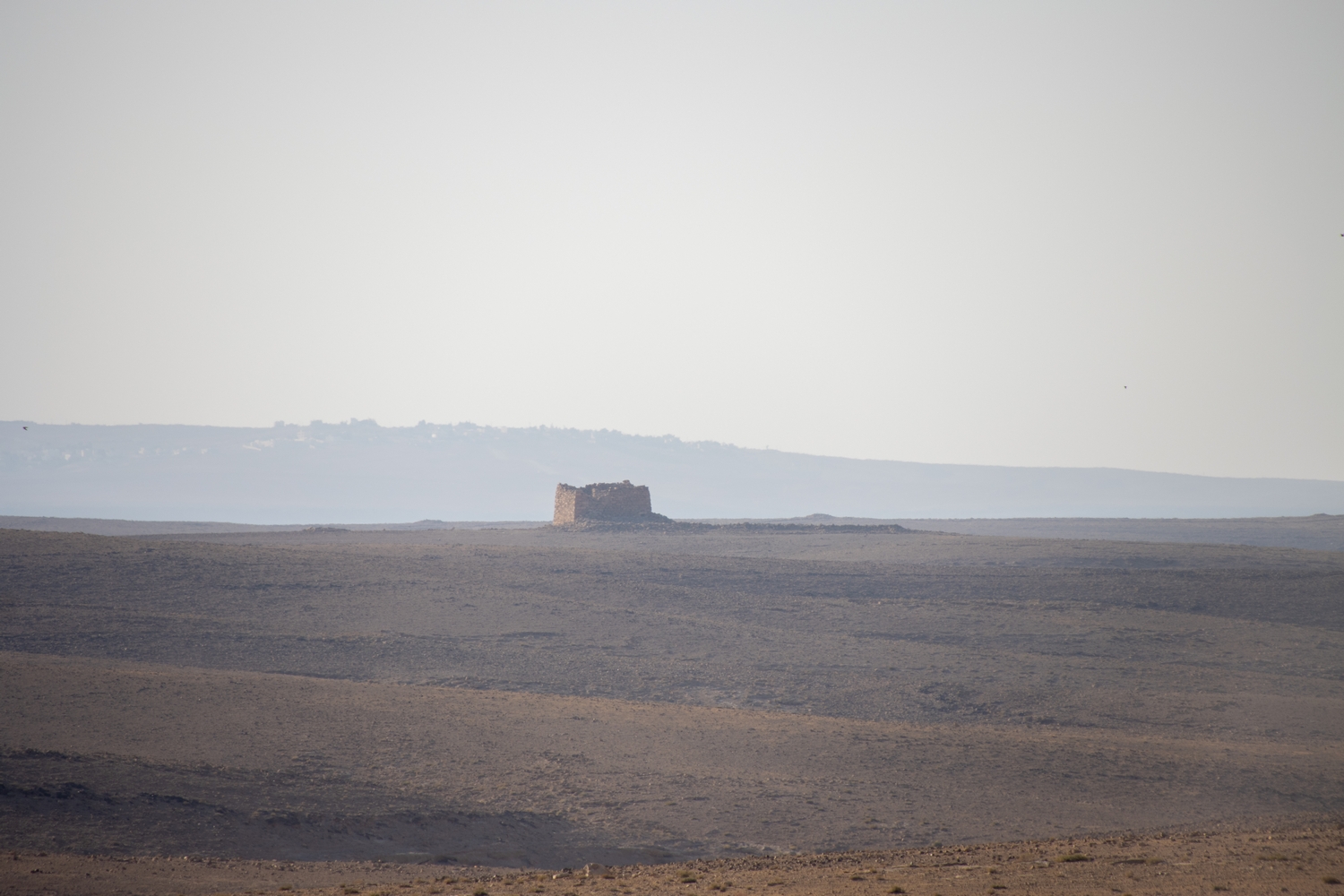
With the Praetorium Mobeni, the Romans had established a central position in the border protection system of this desert border. The Quadriburgium secured Rome in this area together with Qasr eth-Thuraiya, only about five kilometers to the north, the southeastern border of the Roman Empire, which defended, among other things, from looting by Arab nomads and later from the Sassanids had to become. As in most of the border zones of the Roman Empire, the Limes Arabicus did not exist as a continuous closed barrage, but rather from a system of legionary camps, forts, control stations and watchtowers arranged in a chain.

The fort became known for the first time through two research trips carried out in 1897 and 1898 by the Austrian ancient historian Alfred von Domaszewski (1856–1927) and the German-American philologist Rudolf Ernst Brünnow (1858–1917), which covered the Roman Limes and many others visited ancient sites of the former province of Arabia. They were also the first to report on the building inscription.
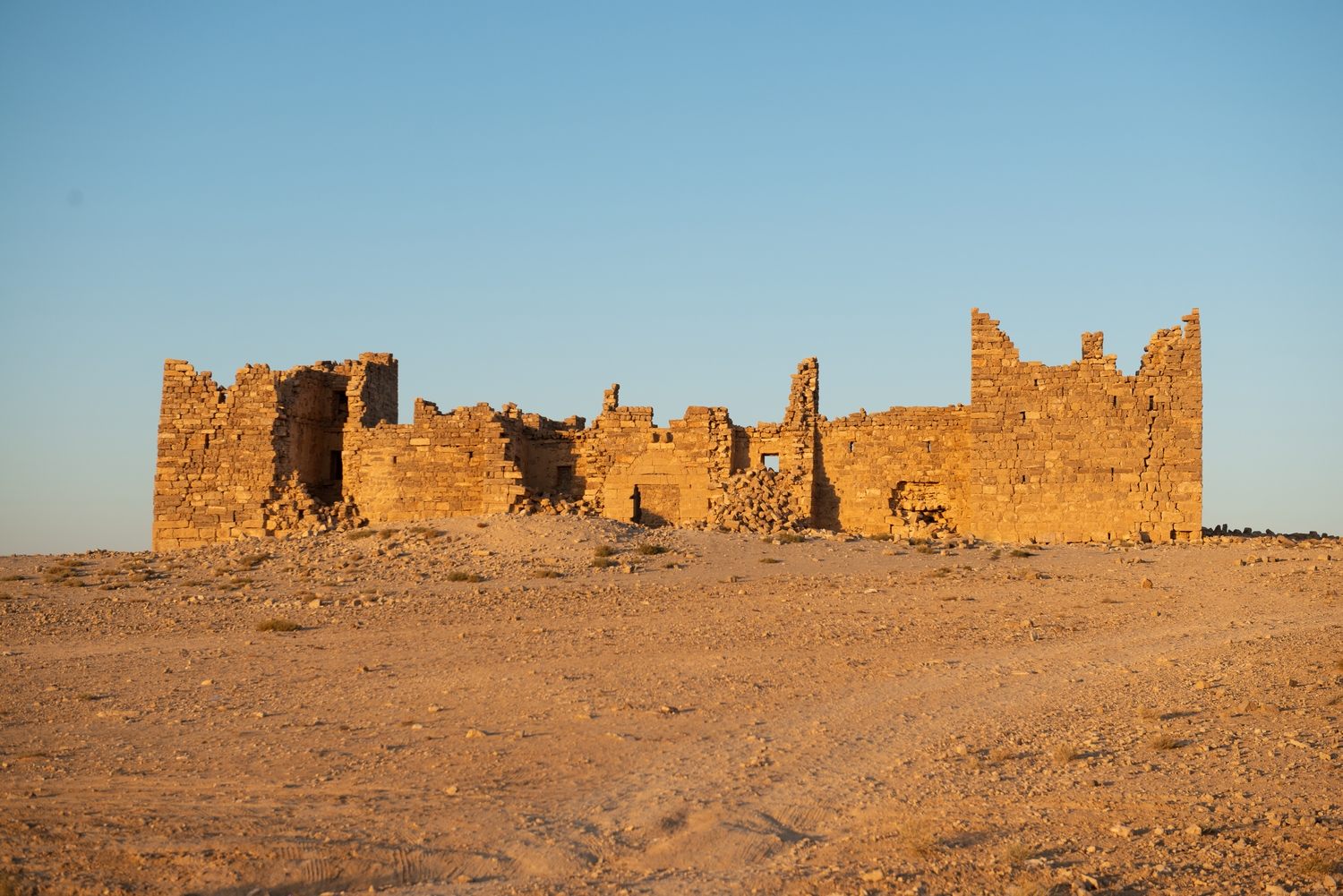
The biblical archaeologist Nelson Glueck (1900–1971), who visited many buildings of the Roman Limes in Jordan in the 1930s, showed no closer interest in the Qasr Bshir and referred to von Domaszewski’s and Brünnow’s descriptions.
Despite these early investigations, the Limes in what is now Jordan was one of the least investigated border regions of the Roman Empire in the period that followed until the early 1980s.
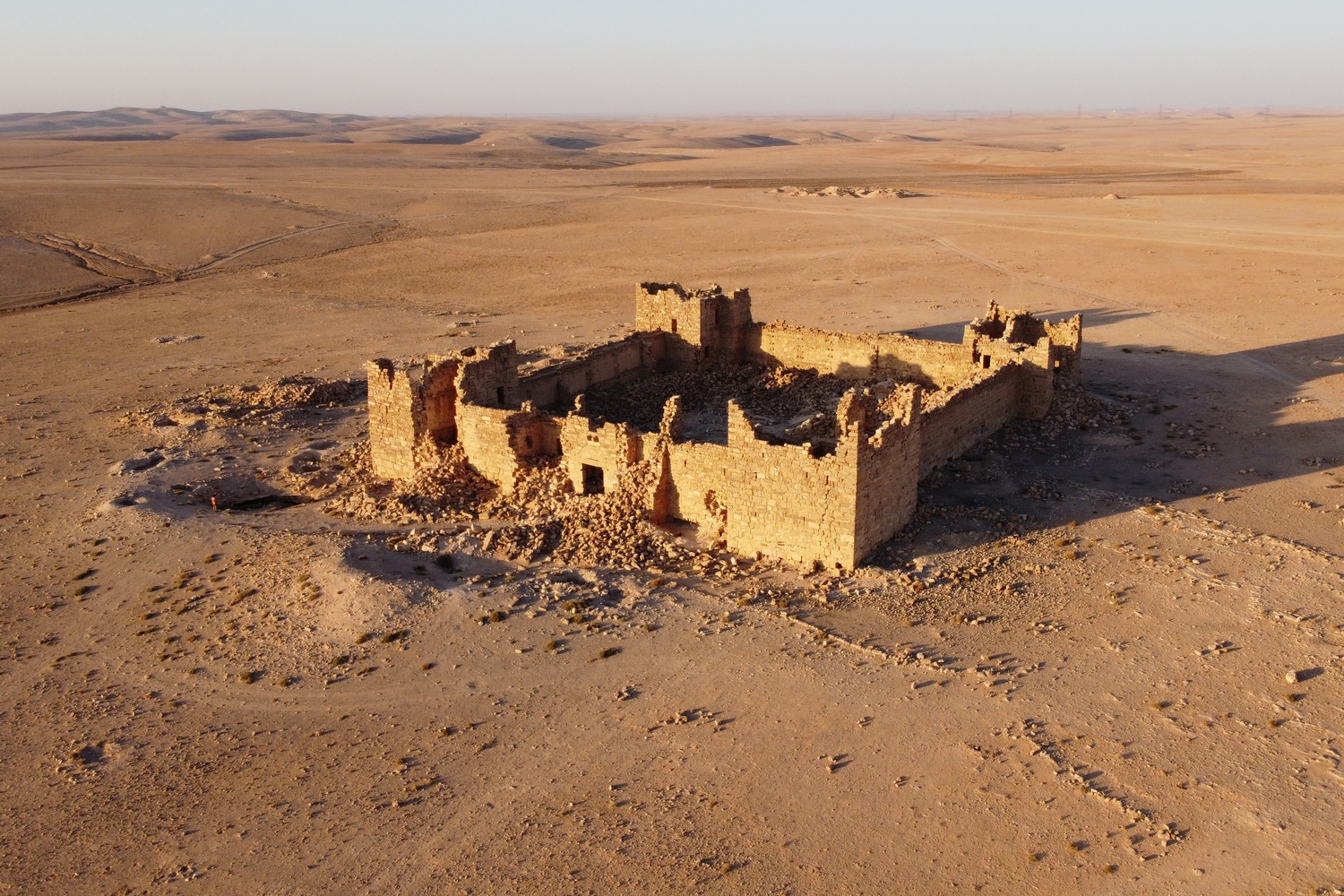
The decisive contribution to the modern research of the late antique Limes Arabicus made the investigations of the American provincial Roman archaeologist Samuel Thomas Parker (1950-2021), who undertook archaeological expeditions with a team of scientists from different disciplines from 1980 to 1989.
As head of the Limes Arabicus Project, he focused on the Roman border in central Jordan. The project was funded primarily through grants from the 1980 and 1982 research campaigns National Endowment for the Humanities funded, the Jordanian Antiquities Service, North Carolina State University, the Dumbarton Oaks Center for Byzantine Studies and the American Philosophical Society also supported. Additional funding came from the National Geographic Society, the Samuel H. Kress Foundation, and private donors.
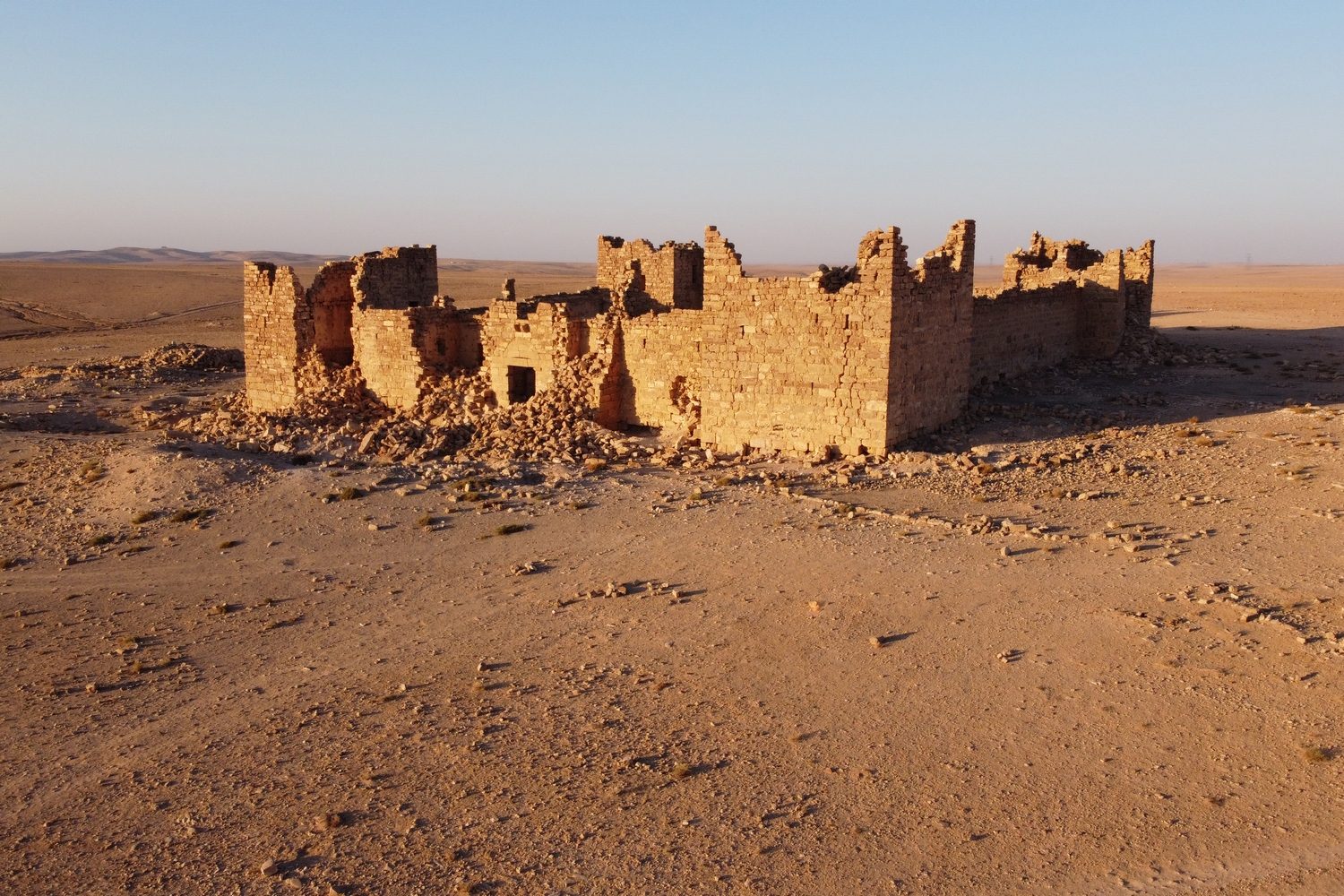
INSCRIPTIONS
With the building inscription reproduced on a tabula ansata, which is still located above the south-western main entrance, the establishment of the complex can be dated to the years between 293 and 305 AD, i.e. the time of the first tetrarchy. With the phrase “a fundamentis”, the inscription also makes it clear that a new building was erected on this site, which was not preceded by a predecessor, as predicted by older research.
Optimistic maximisque principibus nostris Caio Aurelio
Valerio Diocletiano Pio Felici et Invicto Augusto
Marco Aurelio Valerio Maximiano Pio Felici et Invicto Augusto
Flavio Valerio et Constantio Galerio Valerio Maximiano
nobilissimis Caesaribus castra praetorii Mobeni a fundamentis
Aurelius Asclepiades praeses provinciae Arabiae
perfici curavit
Translation: “In honor of our best and greatest rulers, Gaius Aurelius Valerius Diocletianus, our pious, happy and undefeated ruler, and Marcus Aurelius Valerius Maximianus , our pious, happy and undefeated ruler, and for Flavius Valerius Constantius and Galerius Valerius Maximianus, our noblest Caesars, ordered Aurelius Asclepiades, governor of the province of Arabia, to build Castra Praetorii Mobeni from scratch. ”

WATER
As the building inscription reports, the fort was built at the behest of the provincial governor (praeses) Aurelius Asclepiades. It supposedly had the task of serving as a safeguard against the increasing threat from the Sassanids at the time. Even more important, however, is the connection, often established in the desert regions, between the control of the vital wells and cisterns and their monitoring by the Roman army. The Wadi Mujib, through which the rare rainfall in the region was collected, was used by the soldiers to build a water pipe on the ground that was connected to a large, rectangular basin that they built less than a kilometer from their fort. It is believed that the reservoir built in the middle of a wadi was created at the same time as the Praetorium Mobeni was built. The water collector, built from well-hewn stones, was repaired and can now be used again in its original function for Bedouins. Inside the courtyard there were two major cisterns to collect water, today still visible.
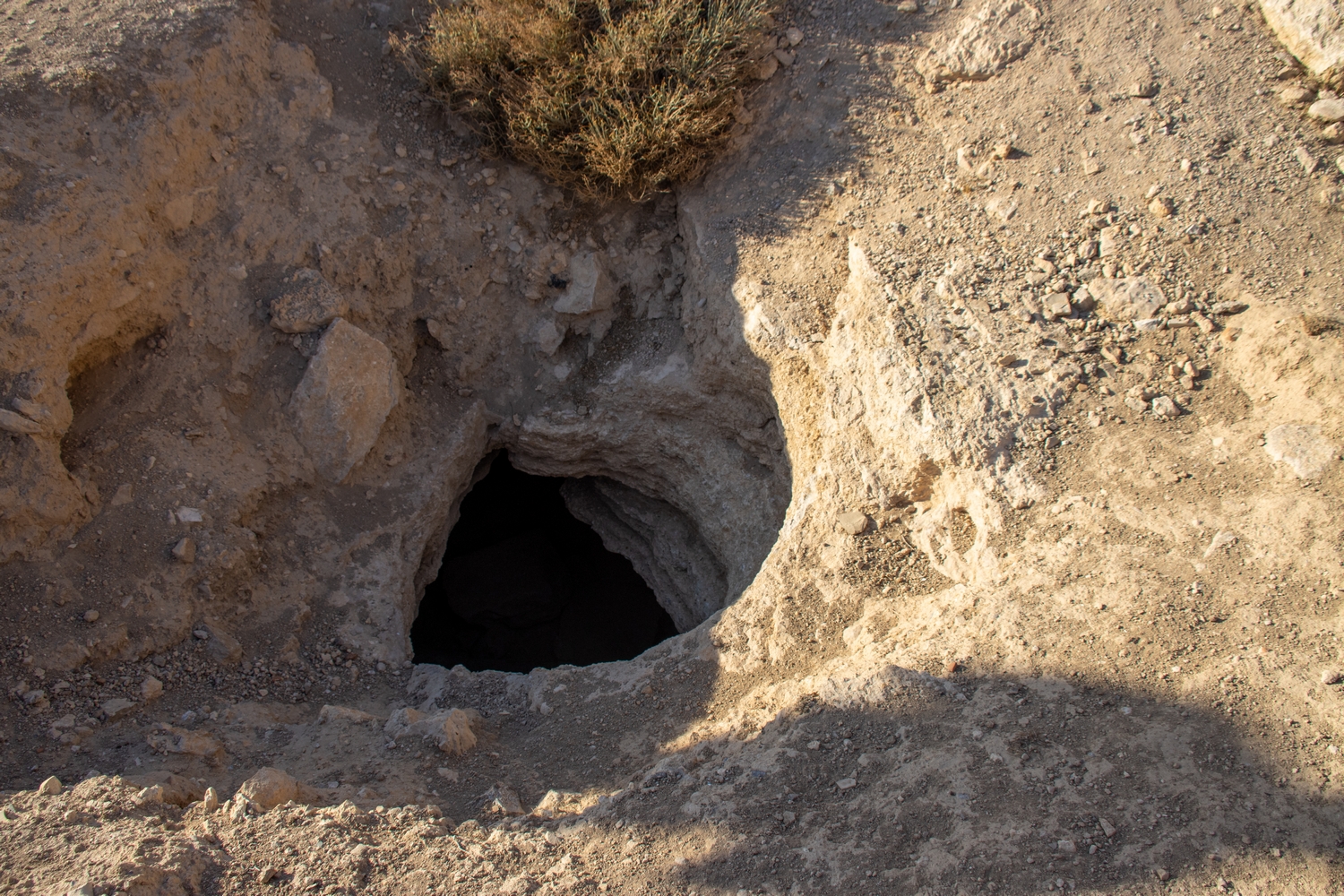
ENCLOSURE
The facility has an almost square floor plan with side lengths of 56.30 meters (SE) × 57.05 meters (SW) × 56.75 meters (NW) × 55.45 meters (NE) (= 0.31 hectares), and, with its four flanking towers, is oriented almost exactly to the cardinal points. The partly rough, partly stronger and smoother masonry of the enclosure is double-shelled.

On its outside, in the lower layers, it consists of mostly thick, mostly cuboid stone different length and height. The sometimes uneven layering of these blocks was compensated for by inserting narrow stone slabs. These monumental-looking blocks are missing from the inner wall shell. The wall core between the two shells is filled with rubble stones mixed with mortar. On the outside, the size of the stone material used gradually decreases towards the top. While the Roman builders left it in the area of the lower, massive stone layers with a non-jointed layering, the smaller, upper workpieces are set in mortar and grouted. The defensive wall was measured at its foot with a thickness of 1.50 meters. It tapers slightly in its upper areas. Plastering could only be found on the inner surfaces of the system.

On the basis of their studies, von Domaszewski and Brünnow assumed that the height of the wall including the stone parapet that was only preserved in remnantswith the today lost pinnacle wreath could have been around 6.50 meters. As the structures that have been preserved for the two researchers, the soldiers could only have reached the parapet via the stairwells in the corner towers. The two only intermediate towers of the fort were at the same time the side towers of the driveway. No stone-set staircase could be found in them, possibly an ascent through wooden structures was guaranteed here.
Parker saw the height and practical ancient use of the defensive wall and parapet suggested by Domaszewski and Brünnow as problematic. He first found that, in contrast to the maximum information from older research, the fencing in the entrance area had been preserved up to a height of at least seven meters. In his deliberations, in any case, he assumed an enclosure wall only about six meters high. Although no remnants of the actual battlement remained, Parker reconstructed this area as a paved path that was protected from the outside by battlements.
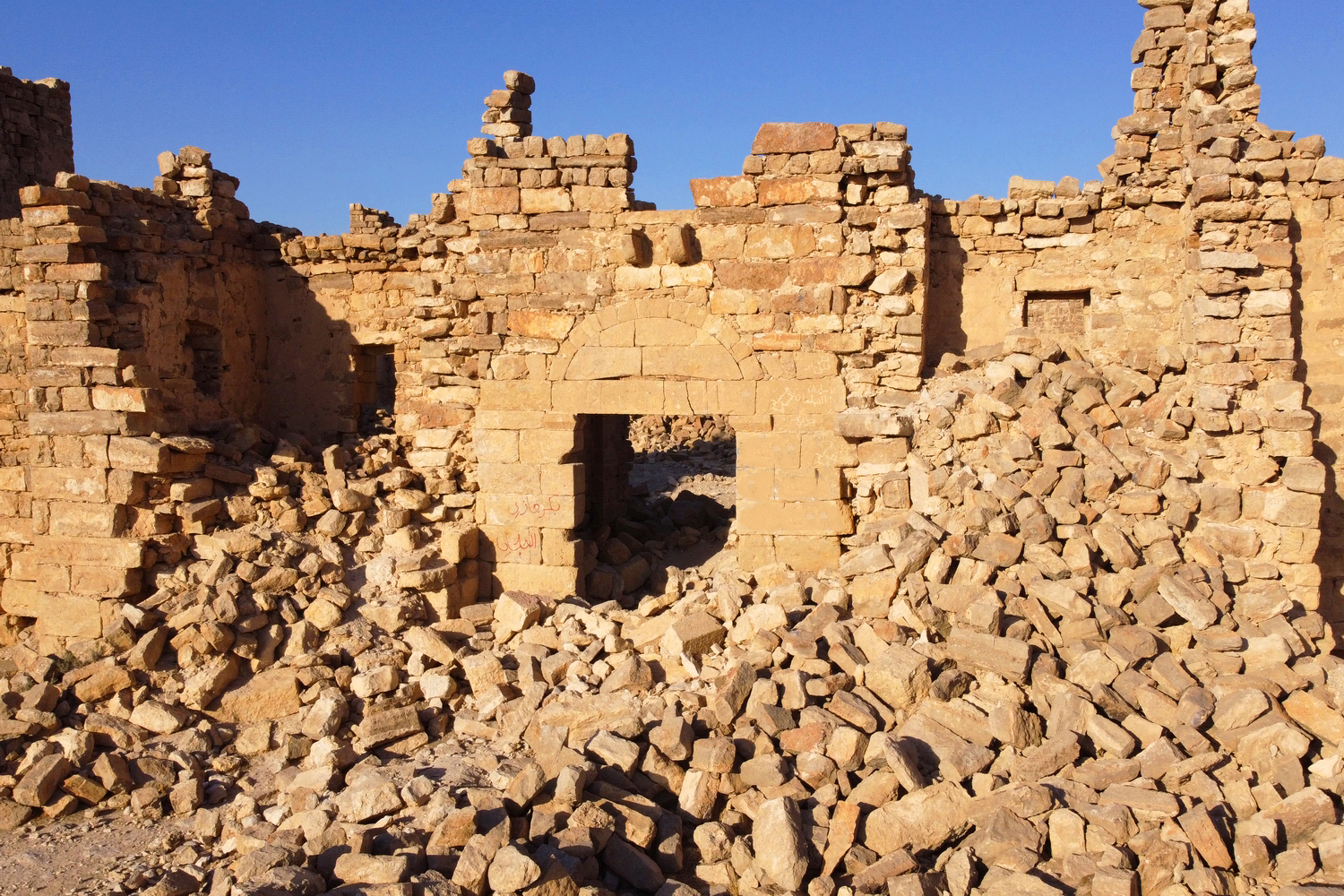
Since after the collapse of the Curtains from these battlements apparently also have no remains, such as tin lids, research remains dependent on speculation in this case as well. Due to the lack of structural evidence, Parker did not see it as sighted that the parapet was accessed via the towers. In analogy to other comparable Roman fort complexes, he believed in further ascents to the battlements in order to be able to occupy all combat stations as quickly as possible in the event of an alarm.

CORNER TOWERS
The four three-storey corner towers, designed as rectangular flanking towers, which are the outstanding feature of the late antique building type of the Quadriburgii, protrude 3.05 meters from the surrounding wall and have a square base area of 11 to 12 meters. They each cover an area of 10 to 20 square meters. With a height of just over 10 meters, the best preserved corner tower is the southern one. Each floor area of these towers was divided into three rooms. The largest room in the south tower took up the outer corner and was made by von Domaszewski and Brünnow with a clear dimension measured 4.83 × 4.65 meters. The other two rooms were around 3 × 3.35 meters and 2.90 × 4.72 meters. Long stone beams rested on the ceilings vaulted by stone arches, the end pieces of which were embedded in the outer walls.

The floor of the upper floors was laid over the stone girders and probably consisted of stone slabs. At the corner facing the central courtyard, there was a rectangular staircase in each of the four towers. This opened up the building to the flat roof that was accessible. The top floor of the flanking towers was probably with a flat roof, The parapet was designed for monitoring and signaling and could also be used as a combat platform in the event of a defense. The fortifications only have small slotted windows on the third floors facing the enemy. Below, on the level of the second floor, there were only very narrow loopholes in both the towers and the defensive wall.

The Praetorium Mobeni was used by the Roman military throughout the 4th century. As early as the early fifth century, however, the traces of use began to decline and, according to the prehistorian Johanna Ritter-Burkert (2018), the garrison was likely to have been abandoned in this secular area. Parker decided in 1990 that the fort would be abandoned no later than around 500 AD.
During his reign, Emperor Justinian I (527-565) transferred the defense to the Ghassanids for a short time in the early 6th century , but the Limes Arabicus ceased to exist soon afterwards. To what extent the Praetorium Mobeni still played a role at all at this time is unknown. A late Byzantine occupation of this period cannot be proven. The abandoned Qasr Bshir seems to have been used as a caravanserai under the Umayyads. Damaged by an earthquake in the 8th century, the former fort was finally abandoned.
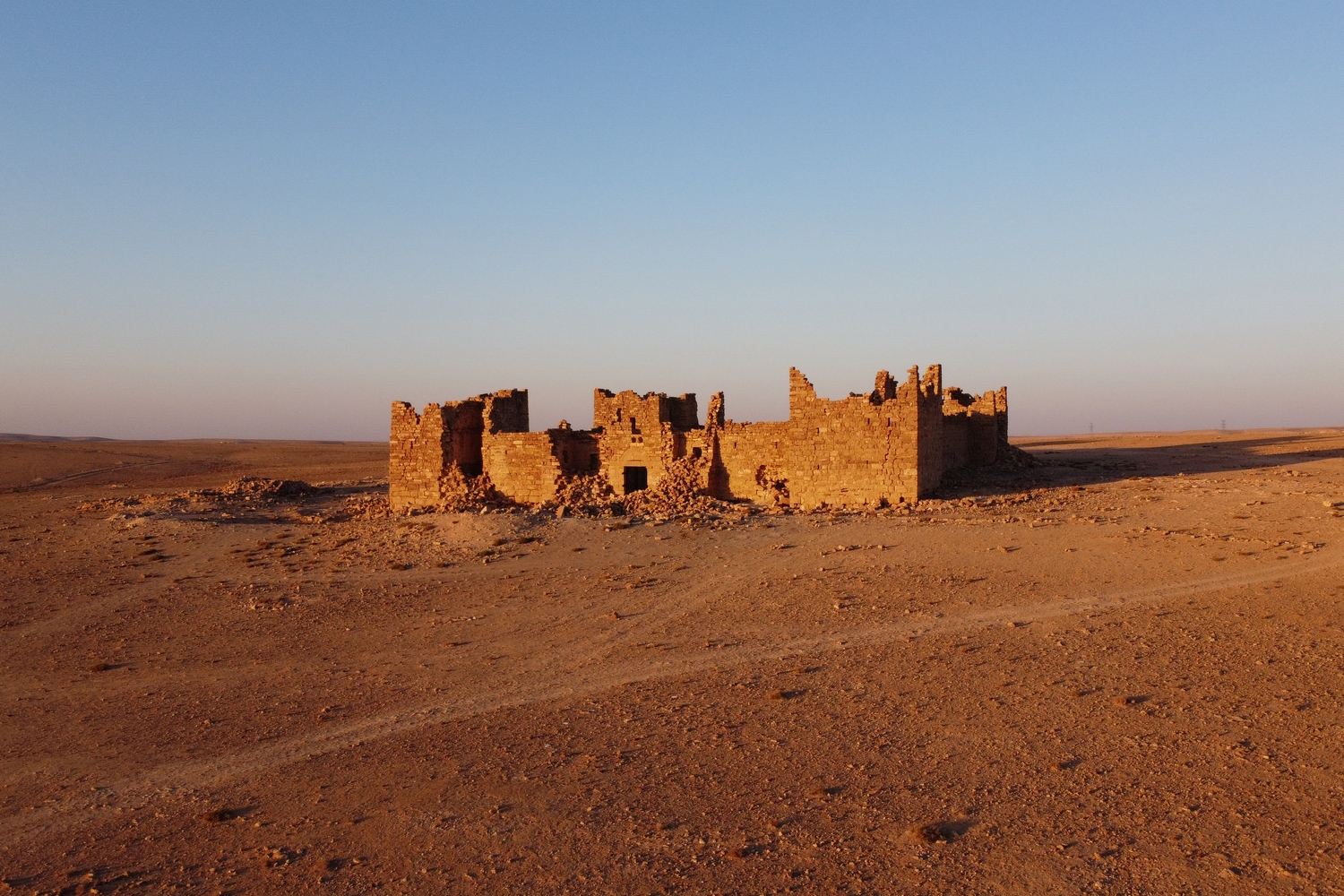
Related Post
A shocking documentary proves that mermaids do exist
SHOCKING Revelation: Thuya, Mother of Queen Tiye, Was the Grandmother of Akhenaten and Tutankhamun—What Ancient Egyptian Secrets Did She Leave Behind?
Breaking News: Astonishing Discoveries at Karahan Tepe Confirm an Extraterrestrial Civilization is Hiding on Earth, and NO ONE Knows!
Breaking News: Researchers FINALLY Discover U.S. Navy Flight 19 After 75 Years Lost in the Bermuda Triangle!
NASA’s Secret Investigation: Uncovering the Astonishing Mystery of the UFO Crash on the Mountain!
Explosive UFO Docs LEAKED: Startling Proof That Aliens Ruled Ancient Egypt!
